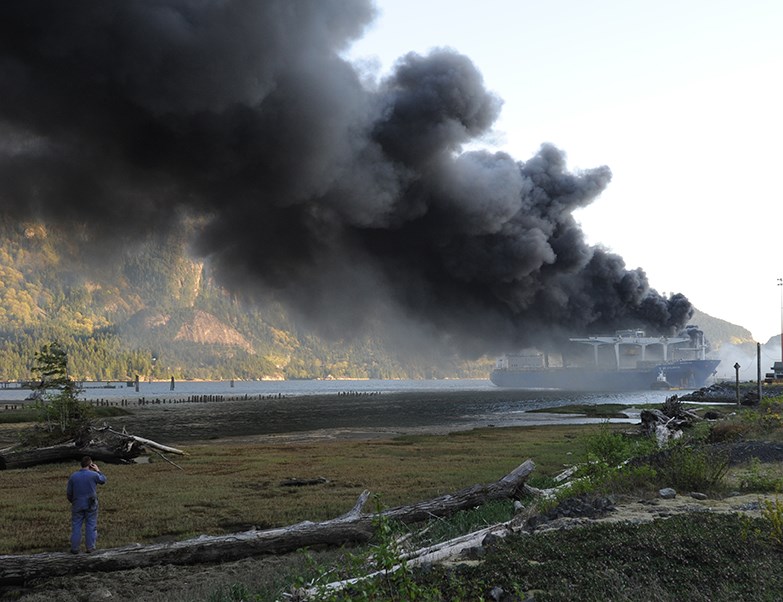Massive fire covers squamish with smoke
It will take more than a year for Squamish Terminals to return to its original state.
On April 16, the sky in Squamish filled with thick, black smoke. The culprit was a huge dock fire at Squamish Terminals.
The massive blaze engulfed the east dock at the facility. Fumes from the burning creosote pilings could be smelled throughout the community, and residents were urged to stay inside until the air cleared.
Thankfully, no one was injured as a result of the fire, Kim Stegeman-Lowe, vice-president of administration for Squamish Terminals, told The Squamish Chief while reflecting on the event.
“We had a quick and unified response by all parties, and the fire was contained to the one dock,” Stegeman-Lowe said.
Residents were reassured by officials that there were no dangerous toxicities in the smoke, despite its density and smell.
“We recognize the fire had an impact on our community and we appreciate everyone’s continued support for Squamish Terminals,” Stegeman-Lowe said.
Vancouver Fire and Rescue sent a fireboat to assist with Squamish Fire Rescue’s attack from the land. Firefighters attributed the blaze to an electrical problem.
In November, the terminals began reconstruction of its east dock. The new east dock is planned to be approximately the same size as the one destroyed by the fire, although it will be a steel and concrete structure. As well, the project will see the construction of a gangway platform that will allow Squamish Terminals to make best use of its operating capacity at the site and enhance safety, according to officials.
Squamish Terminals faces a busy year ahead as the facility anticipates similar cargo volumes as last year through only the one remaining dock for the first half of the year, Stegeman-Lowe said. This will occur at the same time as managing the rebuild – which marks a significant reinvestment toward the Terminals’ future, she noted. The rebuild is scheduled to be complete in late summer in 2016.
“Our team is up for the challenge.”
FortisBC drills boreholes
Votes, boreholes and the court system.
FortisBC came up against a brick wall in the beginning of 2015, when a newly elected District of Squamish council voted against the company’s application to drill test boreholes in the Squamish Estuary.
FortisBC originally proposed to drill five test boreholes in the estuary to determine if horizontal drilling could be done to install a natural gas pipeline to feed the proposed Woodfibre LNG plant. But in late January, a four-to-three council vote stopped the drilling proposal dead in its tracks.
In explaining her vote against the application at the council meeting, Squamish Mayor Patricia Heintzman said it was about setting a precedent. Over the years multiple “small things” have taken place in the estuary, but on a whole they all have an accumulative impact, she said.
“We have to, at some point, start to say, ‘No, we can’t do that any more.’”
Following the meeting, FortisBC spokesperson Trevor Boudreau expressed disappointment.
“We have all of the necessary approvals and regulatory permits needed to conduct the investigative work, and either met or exceeded the district’s established guidelines.”
In March, FortisBC representatives filed a petition against the District of Squamish with the province’s Supreme Court over the denial of the development permit. And by April, the company had submitted a revised application to the district outlining two boreholes be drilled in an already disturbed area of the Squamish River Dike.
This time, FortisBC received approval. Work took place during the summer.
Fortis BC has been taking feedback it has received from the more than 200 meetings its held with the community and Squamish Nation to hone its plans, Boudreau said.
“When the community told us they were concerned about our plan to locate a natural gas compressor station on a properly zoned lot inside the Squamish industrial park, we responded by providing a new remote location,” he said, noting the same applied to the trenchless method of installing new pipe sections.
“If approved, the Mount Mulligan facility would be built about 1.8 kilometres away from the nearest residence in Squamish at approximately 1,400 feet elevation and on the other side of a bluff.”
In 2016, FortisBC’s main goal is to finalize activities to fulfill its requirements of an Environmental Assessment process with both the province and the Squamish Nation, Boudreau said.
“We’re also going to be continuing the dialogue with residents and the larger community,” he said, adding that includes tours of facilities.
FortisBC expects to know the outcome of the environmental assessments by late spring 2016, Boudreau notes.
“Regardless of where we’re at by the end of 2016, we expect there to be much more consultation and dialogue as we work with the community and stakeholders to find the best solutions as we move forward.”
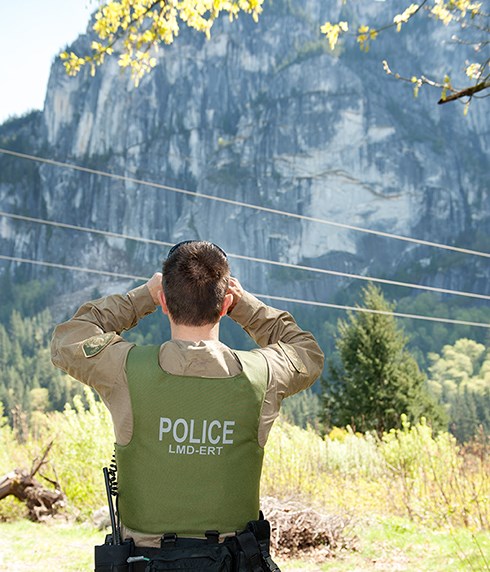
Chunk of Stawamus Chief falls
Approximately 1,600 cubic metres of rock fell from the Stawamus Chief on April 19.
The incident hit international news after an estimated 20-metre wide and 15-metre high piece of rock fell 310 metres off of a section of the cliff known as Angel’s Crest. In a later report commissioned by the Squamish Emergency Operations Centre, it was estimated that based on tree growth below the cliff face, the 2015 rockfall was greater than any other that occurred in the area in at least 60 years.
Local company Global Rock Works removed loose surface material and did rock scaling following the event.
While the rockfall will likely be etched into the minds of local residents for some time, it wasn’t a large event in terms of geology, said Quest University geology professor Steve Quane. The Chief’s famous bouldering routes are made up from such rockfalls.
Overall, the Stawamus Chief is sturdy, he said.
“While we do have a lot of precipitation, we don’t have an extreme climate,” Quane said, noting that more freezing and thawing action that would enlarge the cracks in the rock. The April rockfall happened on the north face, which is more prone to freezing, he noted.
In May, the commissioned geotechnical analysis and report stated natural weathering caused the rockfall. Similar incidents should be expected to occur every 50 to 100 years along the North Wall area of the Chief, the study noted.
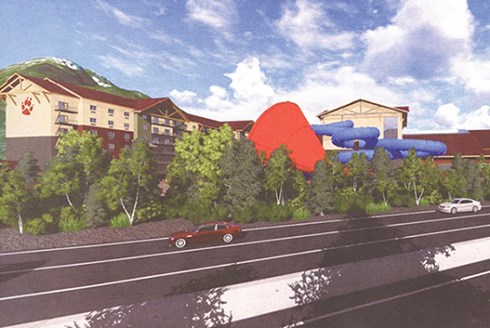
Great Wolf Lodge eyes Squamish
Ready for some wet and wild rides?
The Jim Pattison Group might be. The company has purchased property at Centennial Way and Highway 99 to build a family-focused resort, complete with themed rooms, restaurants and a 100,000-square-foot waterpark.
In November, The Squamish Chief learned that Pattison Group was interested in building a Great Wolf Lodge in Squamish. By December, stakeholders made it official after presenting preliminary plans to the District of Squamish outlining the proposed resort.
“We have done economic studies for a number of different areas – all points lead to this being a premier location for the lodge,” Great Wolf Lodge general manager Keith Simmonds said at a committee of the whole meeting earlier this month.
But don’t book your room and get your swimsuit on quite yet, as it’s too early to say what might happen and when, Simmonds wrote in an email to The Squamish Chief. The hotel chain bought two acres of land but needs more from the district and the province. If that land is found and folded into the project, the plans still require several district approvals, including an Official Community Plan amendment and rezoning.
“What I can say is that if we are fortunate enough to move ahead with the Great Wolf Lodge product in Squamish, we would be thrilled to bring our exciting product to the residents of Squamish as partners, pack members [employees] and guests,” Simmonds states.
The $150 million resort would employ 670; about 70 per cent of them would work part-time.

Four-year-old makes headlines
The McIlwaine family say they are still floored by the outpour of support from around the world.
The family of four made international headlines when the police showed up on their doorstep after four-year-old Tyler was spotted playing naked on the front lawn. On April 19, Ian McIlwaine waxed his car on the warm, sunny Sunday while his sons, Connor, 6, and Tyler played. When Tyler’s clothes got wet, he took them off. McIlwaine thought nothing of it. The four-year-old was having fun.
Three days later, the Squamish RCMP turned up at his household while he was away on a business trip. Apparently the police had received a complaint from a neighbour about the incident.
Police spent more than half an hour asking his wife Margita about the event and, according to the couple, advised her to keep both boys in the backyard if they are naked.
The story was quickly picked up across the country, making the websites of CBC, the Huffington Post and the National Post. Soon after, the family received support from around the world.
“We received messages from hundreds of people from around the globe, including every media format from radio stations to TV shows across the nation, and then international media from England, Germany, Brazil, and the USA,” Ian and Margita wrote in an email to The Squamish Chief.
“It took time, but I personally replied to each and every person who took their time to share their support.”
But what surprised them the most about the ordeal was that people were allowed to make harmful, false accusations with impunity. The incident made them more aware that other people may be watching and judging their actions.
“This should not have been a ‘story of the year’ had common sense prevailed,” the couple states.
The RCMP did apologize for the incident. In a statement RCMP noted the reason for the investigation was to ensure there were no child safety concerns, not that a child was naked.
“They were advised the investigation revealed no such concern, and the file was concluded the day the complaint was received,” Staff Sgt. Brian Cummings said at the time.
Medical marijuana dispensary opens
In February, Squamish’s first medical marijuana dispensary opened its doors.
Former District of Squamish councillor Bryan Raiser hoisted the 99 North Medical Cannabis Dispensary sign above an office on Second Avenue in downtown Squamish. The shop offered medical marijuana in various forms, including dried cannabis, oils, edible and topical marijuana.
At the time of opening, Raiser said the public reaction to the shop had been “overwhelmingly” supportive and positive.
The excitement was short-lived. In March, Raiser received a letter from Squamish RCMP telling him to close his shop or face legal consequences. The letter indicated police were “not in a position to turn a blind eye,” Raiser said. In the letter, police refer to marijuana dispensaries as “illegal.”
On the municipal front, there is “no special permit” from the district to operate a medical marijuana dispensary. Like the dozens of medical marijuana dispensaries in Vancouver and throughout the province, Raiser said, medical marijuana dispensaries do not receive permission from the municipalities in which they are located.
“We are operating in a grey area. No dispensary has a business license because the municipalities can’t give them out,” he said. “We are in a very bizarre, peculiar moment in history.”
In November, Raiser stepped out with Councillor Susan Chapelle to rectify that. At a council meeting, Chapelle put forward a motion that district staff look at marijuana dispensary business licensing. The motion called for adequate fees and zoning, including setbacks from inappropriate locations.
“In uncertain times with legalization and business licences in Vancouver costing $30,000, it is critical to make sure our land use is supporting safe choices for young people,” Chapelle says. “Ensuring that dispensaries have setbacks from public parks, public buildings and schools, as well as being able to recover some costs for municipal protective services with business licences are important policy. If it’s not in place, we will be playing catch up instead of being proactive.”
It’s difficult to know whether these changes will take place in 2016, Chapelle noted. District staff have been busy with bylaw and zoning updates, as well as the municipality’s 2016 Official Community Plan review, Chapelle said.
Chapelle doesn’t think Canada is going to see any big shifts when it comes to marijuana dispensaries any time soon. While new Prime Minister Justin Trudeau has taken a liberal pot stance, the Squamish councillor says she thinks Ottawa has over-promised policy and does not have the resources for the changes.
“I am hopeful for the future,” Chapelle says.

Resort project up in air
This year was a waiting came for Garibaldi at Squamish, the proposed year-round resort planned for Brohm Ridge.
By mid-summer the public comment period to be included in the province’s Environmental Assessment regarding Garibaldi at Squamish had come to a close. In mid-November, project spokesperson Jim Chu said officials with a company backing the plan – Aquilini Development – anticipated the Environment Assessment review process at the end of November.
“We have presented to the provincial Environmental Assessment Office our plan for an all-season resort that will bring massive economic benefits to Squamish,” Chu told The Squamish Chief.
Now stakeholders are stuck on hold, awaiting the province’s final word. If the project to build the $2.9 billion resort gets a green light, then Aquilini Development will begin work on the master development plan, Chu said.
The first step in that process is communicating with Squamish residents, Squamish First Nation and the district about the company’s environmental and community commitments, listening and acting on feedback, he said. Asked what the company aims to accomplish by the end of 2016, Chu said, “We expect that the resort master development plan will be completed and supported by the people of Squamish, the region and the province.
Goldsmith-Jones wins MP seat
She was excited to be elected, so being chosen as the Minister of Foreign Affairs’ parliamentary secretary was the icing on the cake for Pamela Goldsmith-Jones. West Vancouver-Sunshine Coast-Sea-to-Sky Country’s newest MP calls it her biggest surprise in 2015.
On Oct. 19, Goldsmith-Jones beat out Conservative incumbent John Weston, who had held the riding for seven years.
The new MP was mayor of West Vancouver from 2005 to 2011. She declined to run a third term, instead completing her executive MBA at Simon Fraser University’s Beedie School of Business.
On election day, Goldsmith-Jones had a convincing win over Weston, more than doubling his count – 35,818 votes to 17,191.
The election run-up included many highlights, Goldsmith-Jones said. “A campaign is really made up of innumerable efforts that in hindsight are significant,” she noted, pinpointing memories such as talking to former Prime Minister Lester Pearson’s great-niece about Canada’s role in the world and braving the rain and wind with Quest University students who helped her identify the vote. “Election campaigns are full of gestures, grand and small. Those are etched in my mind.”
In December, Prime Minister Justin Trudeau announced Goldsmith-Jones as parliamentary secretary to Stéphane Dion. Trudeau has tasked Dion with issues including improving trade relations and combating climate change.
Goldsmith-Jones said she has a big year ahead, starting with brushing up on her French.
“I have a tutor in Ottawa and in West Vancouver and will live in a French-speaking community this summer in Quebec,” she said, adding she studied French in university and lived briefly in Trois Rivieres in an immersion environment, so she can converse with Minister Dion and her colleagues in the House. “There is no shortage of support and goodwill from my French-speaking counterparts.”
As for her political goals that pertain to her riding, Goldsmith-Jones said she anticipates some changes in 2016 on key issues such as the environment, climate change and rebuilding Fisheries, Oceans and the Coast Guard.
“It has been an outstanding few weeks for Canada, through Minister McKenna’s leadership as a world leader and facilitator at the COP21 summit in Paris,” she said in mid-December. “The mandate letter that Minister Dion and I are responsible for states, ‘Re-energize Canadian diplomacy and leadership on key international issues and in multilateral institutions. This would include in collaboration with the minister of environment and climate change, making Canada a leader of international efforts to combat climate change.’”
Earlier in December, Goldsmith-Jones met with Democratic Institutions Minister Maryam Monsef to support her in the process of electoral reform.
“This is a key issue motivating many to vote for this government who otherwise may not have,” she says. “I look forward to contributing to an open and inclusive process.”
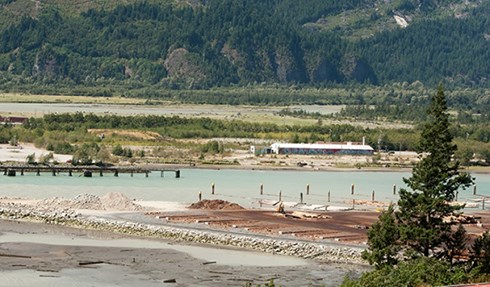
Oceanfront surprise ahead
Eleven years ago, the District of Squamish acquired the Nexen Beach oceanfront lands for $3 from the BC Rail properties. And this year, a purchase and sale agreement was signed, although the actual sale has yet to close.
Mayor Patricia Heintzman, who was among the original members of a group tasked with envisioning the oceanfront, is one of the first people to admit this project has been a long time coming.
“It is a very complicated development,” she said, noting the land includes tidal zones, remediation sites and has to be constructed with climate change in mind.
While the final sale is 99.9 per cent complete, the district is waiting for the province to sign off on something called Section 108, Heintzman said.
The “obscure” land issue deals with land that was once covered by water. The document needs to be approved in order to subdivide the property.
Once that’s done, Heintzman said she anticipates Squamish residents will see movement on the 105-acre waterfront “early in 2016.”
The rezoning on the former industrial chemical plant site was completed this year and Newport Beach Developments is ready to go, she said. To fulfill environmental obligations, the construction of the park will be necessary before any buildings can go up, Heintzman added.
In 2014, Matthews Southwest and Bethel Lands Corp. (now Newport Beach Developments Limited) agreed to buy the land from the Squamish Oceanfront Development Corporation – a municipal subsidiary.
The project will include a mix of commercial, residential and educational facilities.
Heintzman hinted that in 2016, she may be able to share some big news about who may call the Oceanfront home.
“It’s all exciting,” she said.
Fires make for smokey summer
The summer of 2015 could be remembered as the summer of smoke.
In July, Squamish was plagued by smoke as three large forest fires erupted in the Pemberton zone – the Elaho, Boulder Creek and Old Sechelt Mine fires.
Dry, hot temperatures fueled the blazes. The Elaho fire grew to cover 650 hectares, eventually trickling out to 15 hectares after five days of intensive firefighting by 70 firefighters. Most of the smoke produced on July 4 and 5 slowly drifted out of the Sea to Sky Corridor, across Vancouver Island and into the Pacific Ocean. The air was stable enough that the smoke then reversed and drifted back across Vancouver Island and into the corridor, Coastal Fire Centre fire information officer Donna MacPherson said. The Elaho and Boulder Creek fires burned throughout the summer. The Pemberton zone had 35 forest fires – 17 caused by people and 18 caused by lightning.
“There were a total of 19,245 hectares burnt, which was the largest area of any of our zones this year,” said MacPherson.
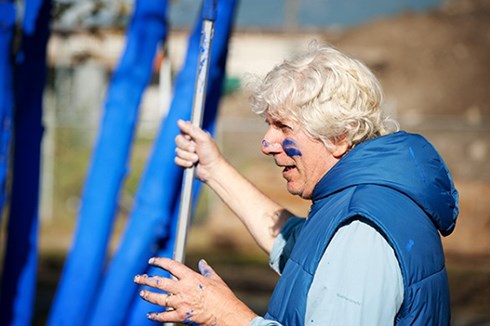
Blue trees paint controversy
Squamish’s newest public art exhibit generated a loud reaction in 2015.
Australian artist Konstantin Dimopoulos came to Squamish as a part of the two-year-long Vancouver Biennale outdoor art show. His project coloured tree trunks with an environmentally safe blue pigment in a quest to bring awareness to environmental issues.
Originally the outdoor art exhibit organizers stated approximately 100 trees in Squamish would be painted and dozens of school children would be involved in the process.
The art organization stated the Blue Tree project would cost Squamish $15,000, with the district contributing $7,500.
The Squamish Chief editorial pages, social media sites and website were inundated with comments from residents about the controversial art. The project began in late October, as Dimopoulos painted a cluster of trees in the District of Squamish’s new park beside the Mamquam Blind Channel and some at Coast Mountain Academy.
Ray Miles, who wrote a letter to the editor objecting to the art project, said seeing the completed work hasn’t changed his mind. While council approved the art project, officials were stating the municipality didn’t have enough money to cut the lawn bowling facility near the Squamish Seniors’ Centre, he notes. “I don’t believe it is art,” Miles says of the project. “There are too many important things that should be attended to. Temporary art is a concept that I have little time for.”
The whole concept of The Blue Trees was to raise awareness and engage people and communities in dialogue, Vancouver Biennale founder Barrie Mowatt stated in an email to The Squamish Chief.
“Through the several newspaper articles, discussions and social media engagement with schools, volunteers and the local community, this project has fulfilled its primary objective,” he wrote. “Unlike some of the other artworks brought to Squamish by the Biennale, this isn’t a physical sculpture or installation, and its true legacy is in the dialogue and social consciousness it has raised in the community.”
While the end result steered away from the original plan to have 50 blue trees in the median along Highway 99, near the entry to Squamish and Garibaldi Highlands, the end result was still significant, Mowatt said. More than 25 trees at Coast Mountain Academy were pigmented with the help of high school students, in addition to the installation in the downtown park.“The installation at Waterfront Park is strong visual artwork that will continue to draw visitors and attention over several months before the pigment starts fading away.”
Squamish is surrounded by nature and this project brought that in focus through an artistic and creative lens, Mowatt stated.
“It has challenged our definition of ‘natural’ while also reminding us to enjoy and appreciate trees in an urban environment.”
Woodfibre LNG gets approvals
In October, the backers of the proposed liquefied natural gas export facility in Squamish heard the words they had hoped to hear: The province granted Woodfibre LNG conditional approval for the project to go ahead.
The news came days after the $1.4-billion-to-$1.8 billion project received a similar conditional nod from the Squamish Nation. Both the BC Environmental Assessment Certificate and the Squamish Nation Environmental Assessment Agreement come with a number of conditions that must be met before construction can begin. Federal approval for the project has not yet been granted.
Woodfibre stakeholders will be focusing on meeting the provincial and Squamish Nation conditions in the coming year, said Byng Giraud, vice-president of corporate affairs.
“Also in 2016, we plan on expanding our business directory, which we launched last year, so that engineering, procurement, construction, installation and commissioning contractors who are bidding on our project have the information they need to ensure qualified local companies are first in line for local contracts,” he said.
On Dec. 8, the District of Squamish council agreed to look at how the Woodfibre LNG project team and municipal staff can work together to meet the conditions of the proposal’s BC Environmental Assessment Certificate, Giraud noted, who said it’s a move that will ultimately build a better project.
How far along the project gets in 2016 depends on federal approval and a final investment decision, Giraud said.
“But ideally, we’d like to see construction at the Woodfibre LNG site,” he said.
The Squamish Nation hopes to resolve three important issues before the project is allowed to move forward, Chief Ian Campbell told The Squamish Chief. Those topics are that Woodfibre must start work on meeting Squamish Nation’s strict environmental conditions, completion of the Squamish Nation-FortisBC Environmental Agreement – so the Nation can decide whether or not to issue FortisBC an environmental certificate for the natural gas pipeline for the Woodfibre plant – and completion of government-to-government discussions between Squamish Nation and the B.C. government. By the end of 2016, Campbell said the Nation hopes to have accomplished further engagement and discussion with the Nation’s membership on all the agreements. The council aims to come to satisfactory resolutions, he said.
